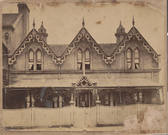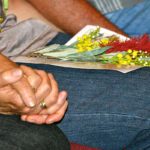Sydney's 'crisis of infanticide' in 1873
- Feb 9, 2018
- In Features
The Infants’ Home (TIH) was one of the recipients of a RAD2 grant which the organisation used to arrange the digitisation of records and images relating to the Home, which are held at the State Library of New South Wales.
As a result of this work, TIH provided the Find & Connect web resource with new information so we could update our entries about the organisation and its records. It was in the course of inputting this new content that I found myself down the wondrous rabbit-hole that is Trove, curious to find out more about the ways in which Sydney society responded to the issue of ‘foundlings’ in the 1870s.
I went looking for more information about the institutions that preceded the establishment of The Infants’ Home in 1877: the Sydney Foundling Hospital (1874 to 1877) and the Sydney Foundling Institution (May to October 1874). The newspaper articles and letters from Sydneysiders about the pros and cons of establishing a foundling hospital yielded new data for the Find & Connect web resource (including a couple of new entities). The material on Trove also was a rich source of information about Sydney in the 1870s and varying social attitudes to ‘illegitimate’ children, single mothers, charity and welfare – some of which seem so strange to the modern reader, and others which are all-too familiar.
In mid-1873, the newspapers were proclaiming that Sydney was in the midst of a crisis of infanticide and child abandonment. In July, the Sydney Morning Herald stated that 6 children had been found dead around Sydney already that year. Public concern peaked when an infant was discovered in Hyde Park, almost dead from strangulation. On 23 July 1873, the Sydney Morning Herald, after proclaiming that ‘Infanticide has now risen to an enormous and characteristic evil‘, concluded that ‘there is no way to meet desertion, which commonly includes infanticide, whether or not intended, but by providing a Foundling Asylum’.
This widespread public concern about child desertion and infanticide was the context in which a meeting took place in Sydney on 5 August 1873. That day, about ‘forty ladies of Sydney’ gathered to consider how none of the existing charitable institutions in Sydney at that time were able to meet the ‘special requirements of this child of immorality and distress – and hence, it might be inferred, the lamentable frequency of infanticide’ (The Sydney Mail and New South Wales Advertiser, 9 August 1873, p.168).

In 1873, the primary institution for single mothers and their children in Sydney was the Benevolent Asylum, situated on the site that today is Central Station. The Benevolent Society founded the Benevolent Asylum in 1821. Some of the women advocating for a new foundling hospital claimed that the Benevolent Asylum was not meeting the needs of single pregnant women. Mrs EB Parnell (who would later be the first president of TIH’s committee) raised concerns about the Benevolent Society’s requirement for a woman to be interviewed by a committee (of men) before she could be admitted to the Asylum. ‘Many unfortunate girls … will not go to a place where they have to meet a committee of gentlemen. For this I think they are to be respected,’ Parnell wrote in a letter to the SMH on 12 August 1873.
Many women also expressed strong opposition to the institutional practice of separating mothers and babies. As Swain and Howe have demonstrated, at this time the widespread belief was that keeping a single mother together with her child was ‘rewarding immorality’ (see, Shurlee Swain with Renate Howe, Single mothers and their children: disposal, punishment and survival in Australia).
The women at the meeting in August 1873 agreed that they would form a committee to work towards establishing a new ‘Foundling Institution and Home for Mothers who do not wish to desert their children’. This decision was the genesis of the Sydney Female Mission Home, which opened in November 1873, located in Elizabeth Street, Sydney. The Infants’ Home claims it was ‘the first’ institution to keep single mothers and children together – Trove shows that this is not quite correct – the Sydney Female Mission Home (SFMH) just predates the Sydney Foundling Institution (the predecessor to TIH, established in May 1874).
TIH’s statement that its founders were ‘visionaries’ who ‘recognised the folly of the dominant view that a refuge would condone immoral behavior’ was absolutely supported by the historic newspapers on Trove. The articles demonstrate the pervasive beliefs these women were up against: that single mothers were ‘depraved’ and that providing them with charity only encouraged ‘immorality’.
In 1876 and 1877, NSW Parliamentarians debated motions to omit the Foundling Hospital from government grants for ‘charitable allowances’ with a majority opposing any public funds being given to the institution. Members of the committees which ran the new foundling institutions were patronised and ‘mansplained’ to by the press:
It is impossible not to applaud the ladies who are wishing so earnestly to provide against the destruction of infant life by such unnatural mothers as have recently been exposing or murdering their illegitimate offspring. But we very much question the wisdom of the plan which is likely to be adopted. The ladies deserve the utmost sympathy and respect; but we fear that their well-meant efforts are in the wrong direction.(The Protestant Standard, 16 August 1873, p.4)
Despite the many obstacles, and the lack of government support, the Sydney Female Mission Home existed from 1873 until at least 1905, and The Infants’ Home continues its work today.






Brian Cherrie
February 11, 2018 4:05 pmWell researched and a great example of our history. I am very pleased with the find and connect site, as I use it frequently and very often refer other people to it. It has great links to all sorts of things that are so useful when we are researching our past. Thank you, Brian Cherrie
Nicola Laurent
February 13, 2018 9:46 amThanks for the kind comment, Brian, and it’s great to hear Find & Connect is useful to you and others – don’t hesitate to get in touch if you have questions (or if you know more about a Home than we do and can help us update the website!) – Cate